SINGAPORE - Grappling with the heat and humidity, and not in the mood for a hot meal? Cold dishes and a refreshing cocktail can go a long way to whet your appetite.
April has been a series of muggy afternoons with intermittent thundery showers. The daily maximum temperature in Singapore is predicted to exceed 35 deg C on some days, with the inter-monsoon season lasting into May.
Minimal toiling over a hot stove is ideal on sweltering days. Cold noodles fit the bill, as these can be served as a one-dish meal – take your pick, from cold capellini to chilled somen – or treat yourself to an appetising dish of wine-steeped chicken.
• Follow Hedy Khoo on Instagram @hedchefhedykhoo.
Go to straitstimesfood.com for recipes, news on the latest food trends and more. Follow our social media accounts on Instagram and Facebook @straitstimesfood
Drunken Chicken

Optimal results require the steamed chicken meat to be steeped in a wine concoction overnight. But the heady hit you get from a bite of Shaoxing wine-infused chicken makes the effort worth your while.
Have it with a cucumber salad if the day feels too heavy for carbs.
Ingredients
4 boneless chicken thighs (950g)
1 tsp salt
1/8 tsp Chinese rose wine
1 Tbs white rice wine
3 Tbs Shaoxing wine
400ml water
4 pieces of danggui (Chinese angelica)
12g rock sugar
1½ flat Tbs salt
15g wolfberries
350ml Shaoxing wine (for soaking liquid)
You will need four pieces of aluminium foil of about 30cm by 30cm each.
Method
1. Remove any remaining bones in the chicken thighs.
2. Marinate the chicken meat in 1 tsp salt, Chinese rose wine, white rice wine and 3 Tbs Shaoxing wine. Cover with cling wrap and refrigerate for one to two hours.
3. In the meantime, add the danggui into a saucepan and bring to a boil. Add rock sugar, 1½ flat Tbs salt and wolfberries. Allow the mixture to simmer until the rock sugar has dissolved.
4. Turn off the heat and set the mixture aside to cool to room temperature.
5. Remove chicken from the fridge.
6. Place one piece of boneless chicken thigh, skin side down, on a piece of foil. Roll the chicken meat up in the foil as tightly as possible. Twist both ends of the foil tightly.
7. Roll up the remaining three pieces of boneless chicken thigh in the same way.
8. Place the foil-wrapped chicken rolls in a heatproof tray.
9. Steam over medium heat for 20 minutes. Turn off the heat and allow the chicken to continue cooking in residual heat for 10 minutes.
10. Remove the chicken rolls, still in their foil, and plunge them into a large bowl of iced water. Soak for 15 minutes.
11. Reserve the steaming liquid and allow it to cool.
12. To prepare the soaking liquid, take a large glass container with an air-tight cover and pour in the danggui mixture, the reserved chicken steaming liquid and 350ml Shaoxing wine. Stir and allow the mixture to cool.
13. Unwrap the chicken rolls and discard the foil wrappers.
14. Place the chicken rolls into the soaking mixture. Put the lid on the container and leave it in the refrigerator to soak overnight.
15. When ready to serve, slice the chicken rolls into 1cm-thick pieces.
16. Plate and drizzle a little of the soaking liquid for more oomph. Serve chilled.
Serves four to six
Cold Capellini
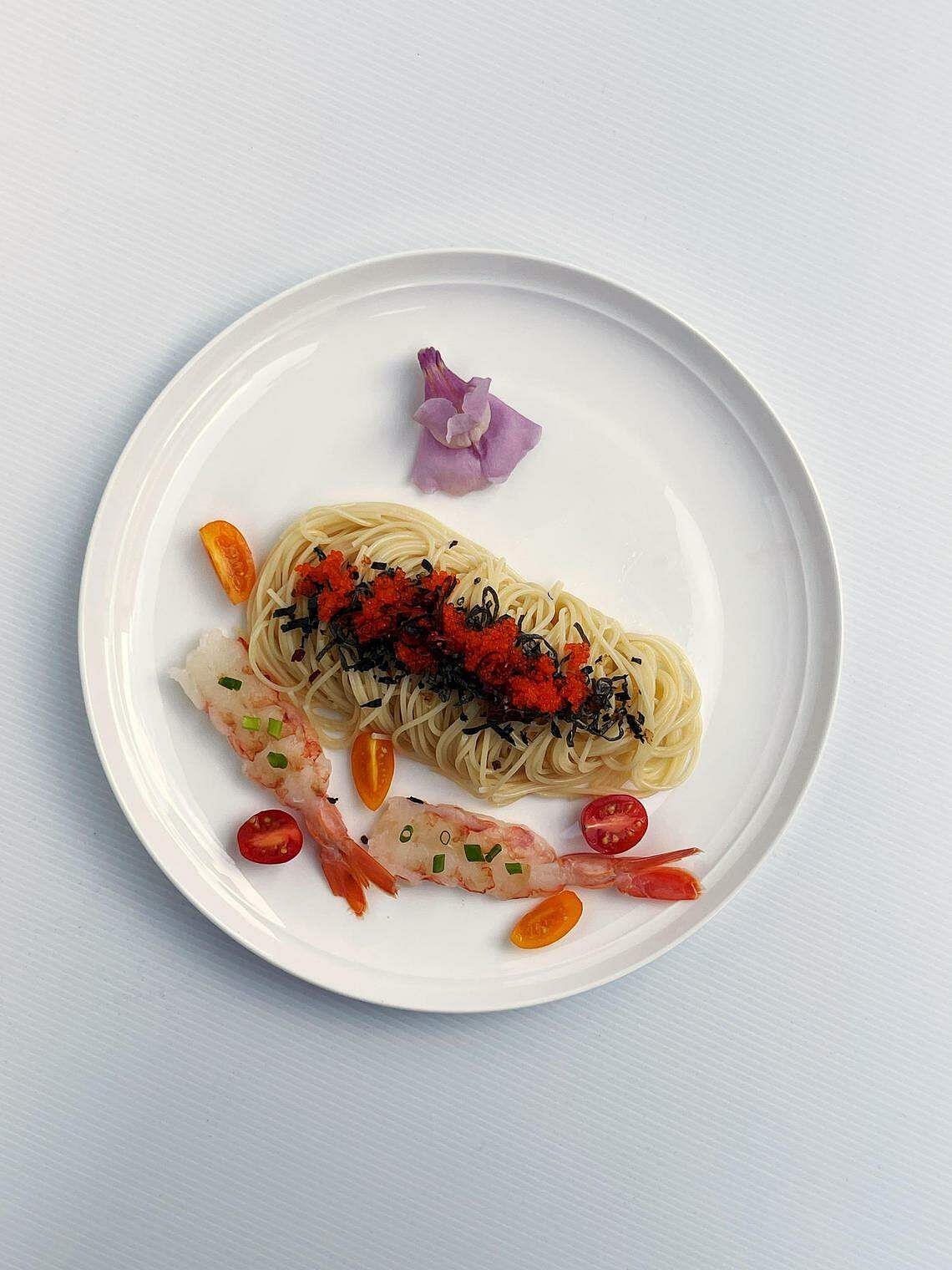
The backbone of the noodles is leek oil, which you can prepare with a few simple ingredients. Use it to flavour other dishes like salads and soups.
Shio kombu (seasoned kelp), furikake (seasoning blend) and tobiko (flying fish roe) add umami, so there is no need to further season the dish with salt. Cooking the pasta in salted water also amps up its flavour.
For an indulgent version, I add aka ebi (Argentine red shrimp) to the dish. Go for other sashimi-grade seafood such as scallops, fish or even sea urchin, depending on your preference and budget.
Ingredients
2 litres of water
2 tsp salt
300g capellini
4 Tbs leek oil (see how to make leek oil)
30g shio kombu (seasoned kelp)
2 tsp furikake (seasoning blend)
4 tsp tobiko (flying fish roe)
4 cherry tomatoes, quartered
12 pieces of sashimi-grade aka ebi (Argentine red shrimp)
1 stalk of spring onion, sliced
Method
1. Bring 2 litres of water to a boil. Add salt.
2. Add the capellini, and cook according to the packet’s instructions, until al dente.
3. Drain and plunge the pasta into iced water.
4. Once chilled, discard any remaining ice.
5. Place the pasta in a colander to drain excess water.
6. Transfer the pasta into a clean mixing bowl.
7. Add the leek oil and mix thoroughly.
8. Place one quarter of the pasta on each plate.
9. For each plate, garnish with shio kombu, furikake, cherry tomatoes and three pieces of the aka ebi. Garnish with spring onion.
10. Serve immediately.
Serves four
Leek Oil
Ingredients
17g ginger, sliced
1 stalk of leek (260g), sliced
2 garlic cloves, sliced lengthwise
550ml olive oil
Method
1. In a deep-frying pan, add the oil.
2. Add the ginger, leek and garlic.
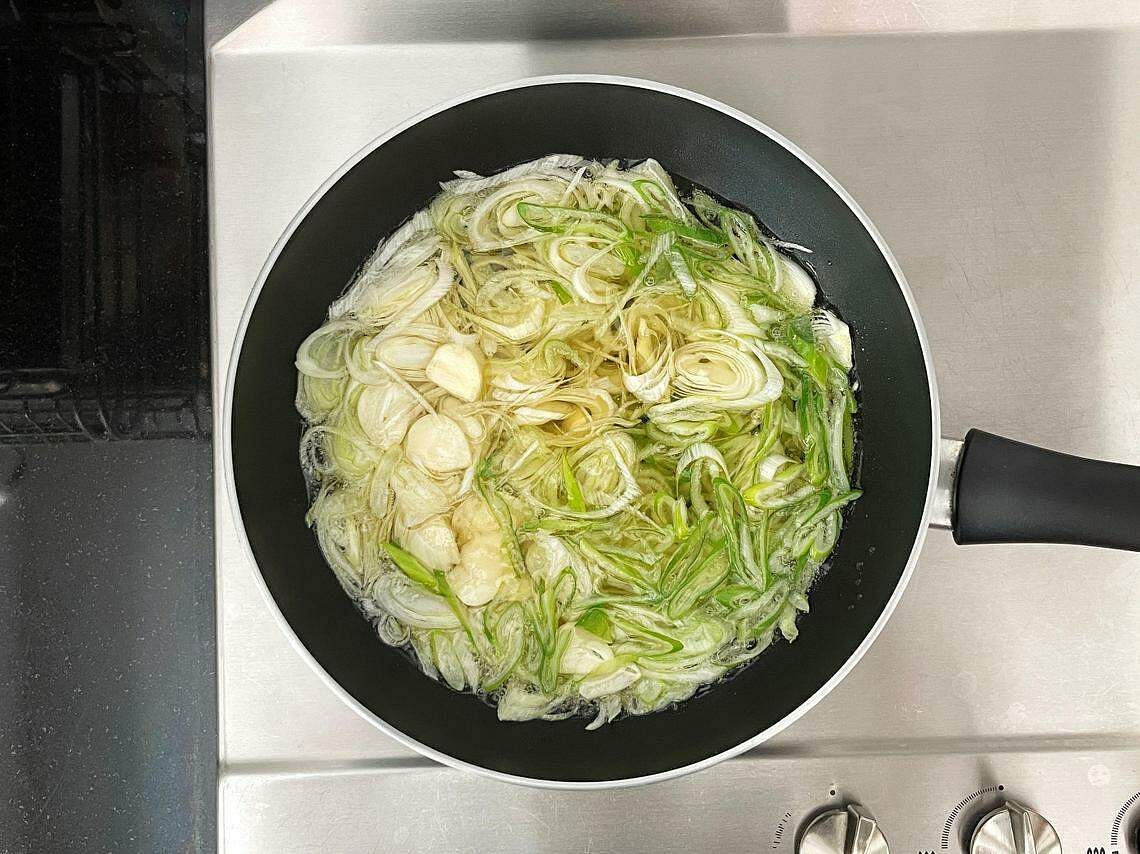
3. Cook over low heat for 17 minutes.
4. Turn off the heat and let the leek continue cooking in the residual heat until browned.

5. Strain and reserve the oil in a jar. Let it cool before putting on the lid.
6. Save the cooked leek for frying with egg, rice or vegetables.
Makes one large jar
Chilled Somen
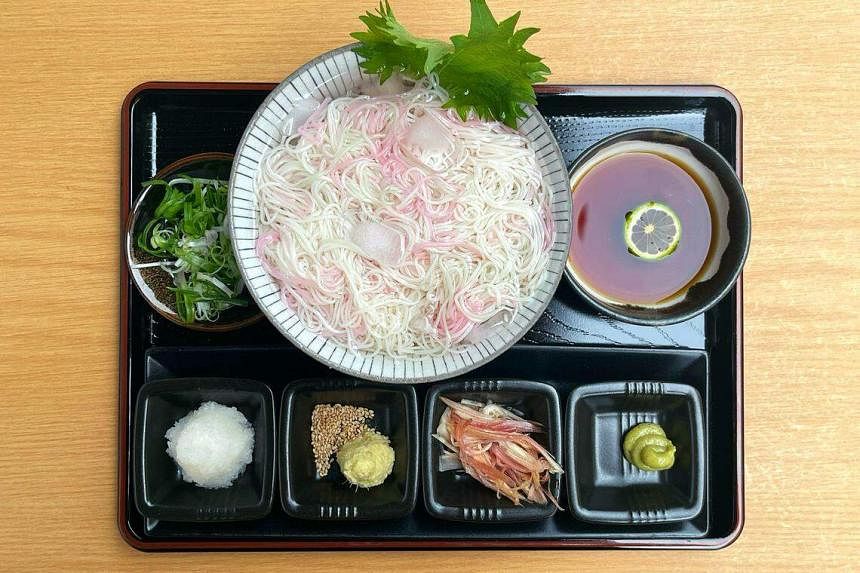
Instead of buckwheat and green tea noodles, try somen, typically served chilled with a dipping sauce. Made from wheat flour, the thin, salty strands of slurp-worthy noodles are similar to local mee sua.
I pick up a pack of Kanesu Somen Ibonoito Ajisansai, handmade dried wheat noodles which come in 250g packets at Meidi-ya ($7.87). You can get other brands at other supermarkets.
Use two bundles (100g) for each serving. Cook them for 1½ to two minutes, then soak in iced water. Serve on a mound of ice cubes or in a bowl of iced water.
Dashi is not difficult to make, but a store-bought dipping sauce works fine. Some tsuyu sauces (Japanese soup base) come concentrated and require diluting with water. Dashi Kara Tsukutta Soba Tsuyu (300ml bottle, $10.90), also available at Meidi-ya, can be used.
Jazz the dish up with yuzu juice or a slice of large lime for a citrusy finish.
Have the noodles with the plain dipping sauce and chopped spring onion as a simple garnish. Or splurge on myoga ginger bulb (Japanese ginger) for a fancier version. You can have it raw, but I prefer to soak it for a few minutes in sushi vinegar and mirin.
Other flourishes to add are grated daikon, grated ginger or toasted sesame seeds. Then dunk them with your noodles in the sauce and slurp up.
Ingredients
60g myoga ginger bulb, sliced lengthwise
1 Tbs mirin
2 Tbs sushi vinegar
350g daikon
35g ginger
400g dried somen
4 perilla leaves
8 drops of yuzu juice
4 slices of large lime
300ml tsuyu sauce
2 tsp of roasted sesame seeds
2 stalks of spring onion, finely sliced
Method
1. Place the sliced myoga ginger, mirin and sushi vinegar in a small bowl. Mix well. Cover and leave in the fridge while you prepare the rest of the ingredients.
2. Grate the daikon and drain off excess liquid.
3. Grate the ginger finely and drain off excess liquid.
4. To cook the dried somen, bring a large pot of water to a boil and cook the noodles for no more than two minutes. Drain and rinse under running water.
5. Serve each portion of noodles in a bowl of water with ice cubes. Add a perilla leaf as garnish.
6. Make the dipping sauce: In a small bowl, add two drops of yuzu juice, a slice of lime and 75ml of tsuyu sauce.
7. Arrange the pickled myoga ginger, grated daikon, grated ginger, sesame seeds and spring onion on a serving plate.
8. Serve the noodles, dipping sauce and toppings.
9. To enjoy, add the toppings into the dipping sauce.
Serves four
Lemon Pasta
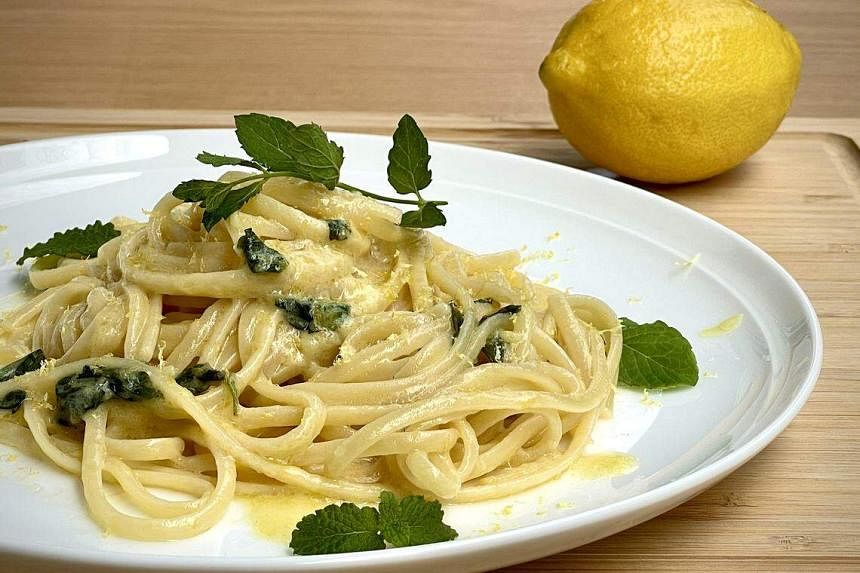
A number of online recipes for lemon pasta, or pasta al limone, call for butter or cream.
I prefer a less dairy-laden version, such as YouTuber Vincenzo Prosperi’s recipe for spaghetti al limone sans butter and cream.
The Italian-born, Sydney-based food enthusiast living is emphatic that cream is not necessary.
I agree, but not on his use of an entire lemon for each person eating this dish. Two tablespoons of freshly squeezed lemon juice a serve is about right. Cut that down to one or 1½ tablespoons of lemon juice if you prefer less tartness and acidity.
When grating the lemon peel, be careful not to include the bitter white pith.
Organic lemons are pricey but worth the money, especially when the recipe calls for lemon zest.
I find organic lemons at Quan Fa Organic Farm’s retail outlet at 01-19 Cheng San Market & Cooked Food Centre, Block 527 Ang Mo Kio Avenue 10 (open: 6 to 11.30am, Tuesdays to Sundays; closed on Mondays).
The organic lemons from Australia and the United States cost around $2 each and are packed in pairs. Using organic lemons saves you the trouble of removing the wax usually found on non-organic specimens.
Pecorino Romano or Parmesan cheese is suitable for the dish.
For the pasta, I use Granoro No. 182 Linguine, which is made in Puglia, Italy. It is available for $2.95 for a 500g packet at Redman, but you can use other brands. Follow the cooking instructions on the packet.
For this recipe, boil the pasta two minutes short of the recommended cooking time, as you will continue cooking it in the frying pan. Be sure to reserve the starchy pasta water, as it helps emulsify the sauce once you add the cheese.
Use either mint or sweet basil to lift the lemony flavour of the pasta.
The salted pasta water and cheese should be sufficient to season the pasta. If you must, sprinkle a little sea salt before serving.
Ingredients
2 litres of water
1 Tbs salt
100g dried linguine
1 whole organic lemon (143g)
2 Tbs extra virgin olive oil
2 Tbs lemon juice
100ml to 120ml pasta water
8g fresh mint or sweet basil
25g freshly and finely grated Parmesan
Method
1. Bring 2 litres of water to a boil. Add salt to the boiling water.
2. Add the linguine and cook for 10 minutes, or two minutes under the cooking time recommended in the instructions on the packet.
3. Meanwhile, finely grate the lemon peel to get the zest. Leave a small portion of the peel to grate over the cooked dish as garnish later.
4. Halve the lemon and squeeze it to get two tablespoons of juice. Set aside the juice.
5. Heat a frying pan over low heat. Add the extra virgin olive oil, lemon zest and lemon juice. Bring to a simmer and switch off the heat if the pasta is not done cooking yet.
6. Heat it up once more when the pasta is almost done cooking.
7. Reserve 120ml of pasta water.
8. Use a pair of tongs to remove the pasta from the pot and transfer it directly to the frying pan.
9. Add 100ml of pasta water or 120ml if you prefer a little more sauce.
10. Switch the heat to high and cook for another minute.
11. Add a few mint or sweet basil leaves, then cook for another minute.
12. Switch off the heat and add the Parmesan. Toss quickly.
13. If you want a little more sauce, you can add a little more pasta water and toss vigorously.
14. Plate the linguine and grate a little more lemon zest over it. Garnish with a sprig of mint leaves or sweet basil.
15. If desired, sprinkle sea salt over the pasta to season it further.
Serves one
Lemon Jelly
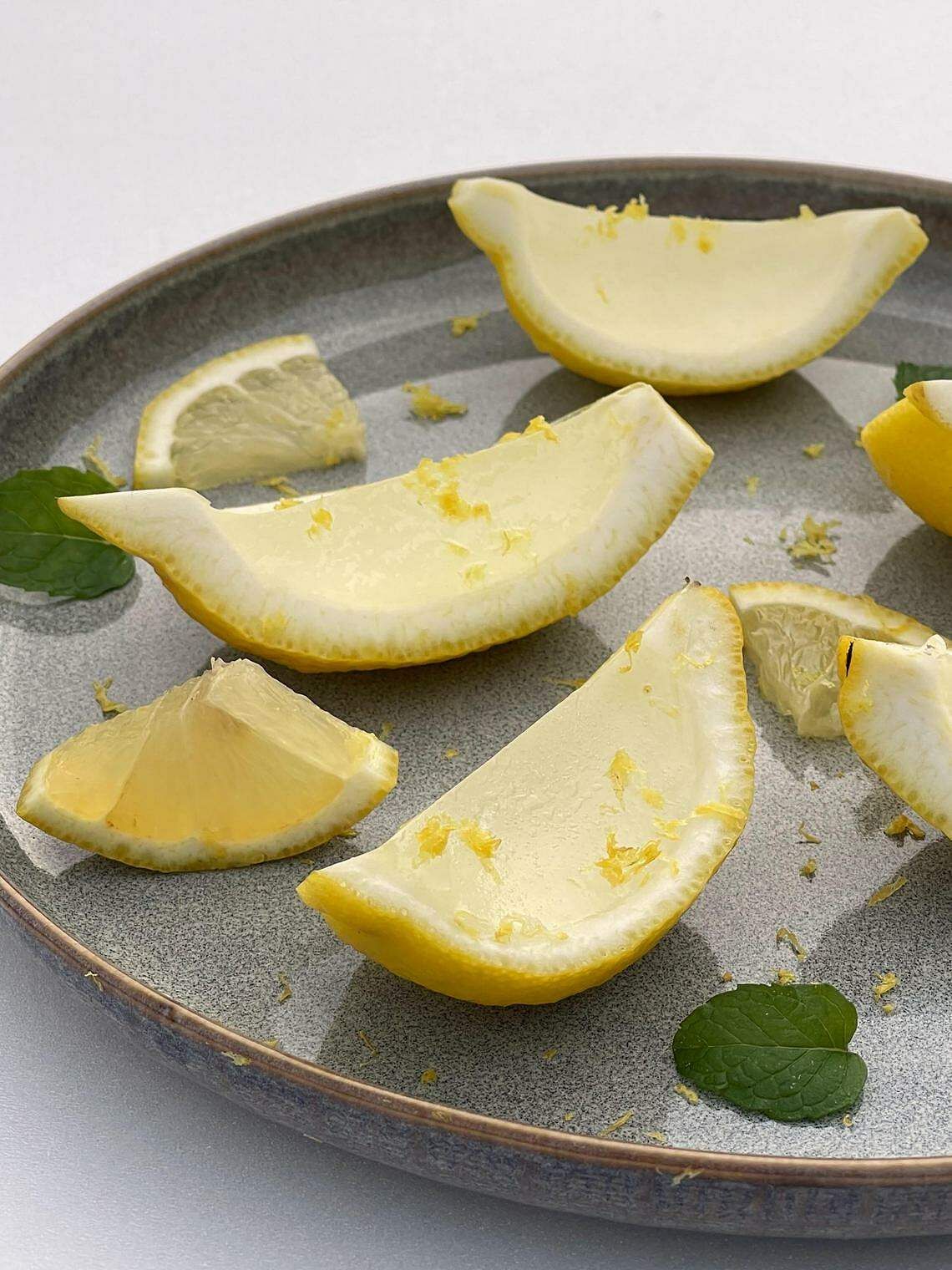
When life gives you hot weather, make lemon jelly by using lemon halves as cups.
You can use gelatin or agar agar powder, but I opt for konnyaku jelly powder as it is vegetarian and I like its soft, chewy texture. Choose the unsweetened powder version so you can control the amount of sugar.
I use caster sugar as it dissolves more quickly, but regular white sugar is fine too.
The tricky part about using konnyaku jelly powder is that you have to mix it with sugar first. Add the mixture into boiling water, a little at a time, stirring continuously for about five minutes.
I use four lemons, from which I extract about 200ml of juice. You will need only 120ml for this recipe. Use the remaining lemon juice for a lemonade or a limoncello cocktail.
Pour any excess jelly mixture into another heat-proof container or jelly mould. Cube it and add it to your cocktail or lemonade for the texture and extra slurping enjoyment.
Ingredients
4 lemons (764g)
120ml lemon juice
850ml water
200g caster sugar
1 packet of unsweetened konnyaku jelly powder (10g)
Method
1. Wash and dry the lemons. Halve the lemons and remove the pulp using a spoon. Scrape the interior of the lemons clean, setting aside the pulp in a bowl.
2. Place the pulp in a muslin cloth or metal sieve, and squeeze to extract the juice. Reserve 120ml of lemon juice for use.
3. Take a paper towel and dry the lemon cups. Place these in airtight containers and set aside.
4. In a saucepan, bring 850ml of water to a boil.
5. In the meantime, place the caster sugar in a bowl and mix in the konnyaku jelly powder.
6. Once the water boils, add the konnyaku powder and sugar mixture, a little at a time, while stirring continuously. Let the mixture simmer and continue stirring for five minutes.
7. Switch off the heat and add the lemon juice. Stir well.
8. Pour the mixture into each lemon cup. Allow the jelly mixture to cool. Refrigerate for one hour or until the jelly is firm.
9. You may wish to halve each lemon cup for presentation. Arrange on a plate and grate more lemon zest over the jelly if desired. Serve immediately.
Serves eight to 10
Basil Limoncello Cocktail
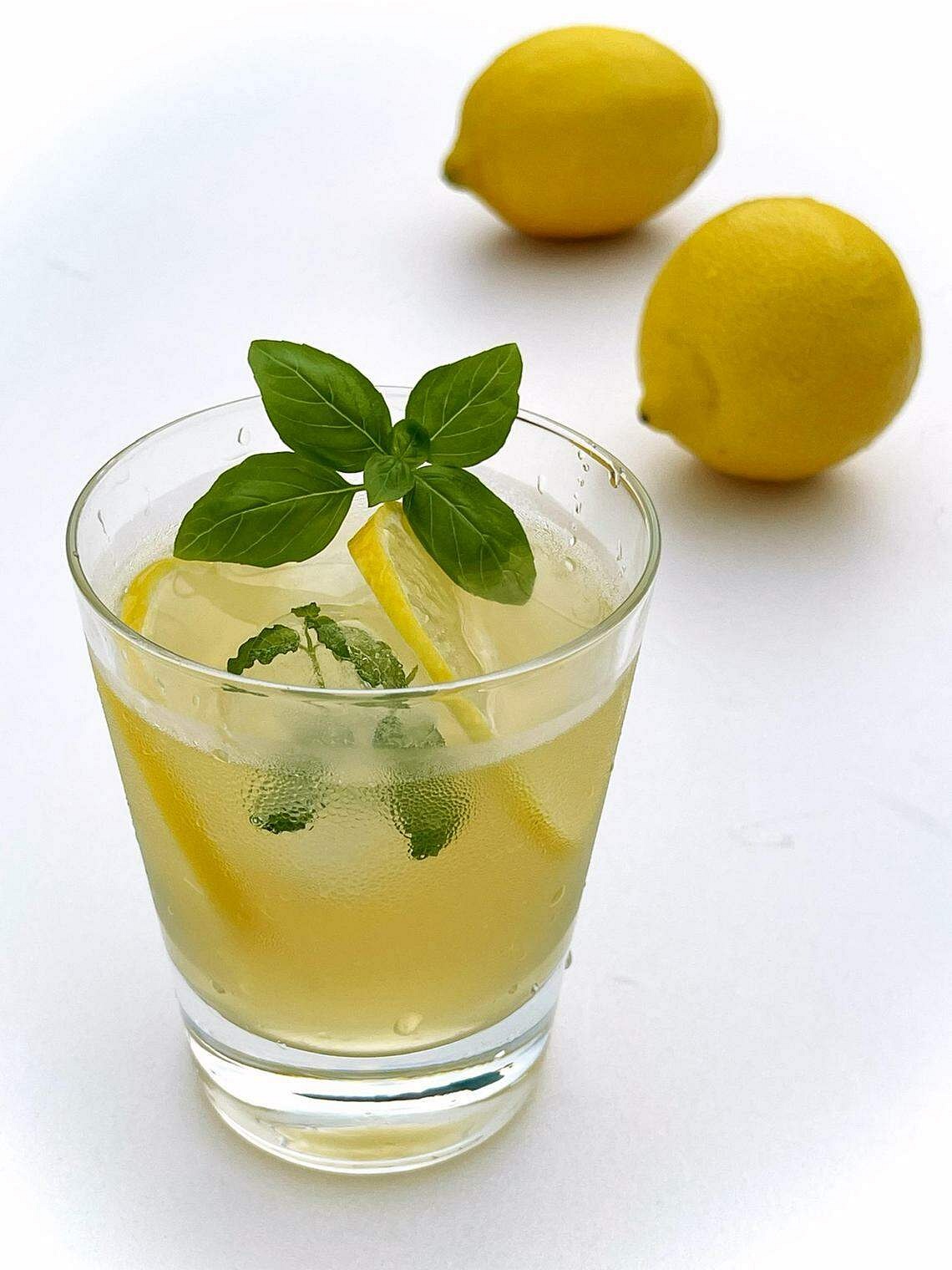
Limoncello is an Italian lemon liqueur that is usually served straight and cold.
If you find it too strong to drink on its own, try it in this cocktail. Use freshly squeezed lemon juice left over from preparing the lemon jelly or lemon pasta.
For sweetness, I use elderflower cordial as it saves me the hassle of making a sugar syrup. You can use Marks & Spencer Elderflower Cordial, available on FairPrice’s website at $9.50 for a 500ml bottle. I recommend 30ml of it for this recipe.
If you want to skip the elderflower cordial, make a simple syrup with a ratio of one part water to one part sugar, or a thicker syrup using one part water to two parts sugar. Boil these together to dissolve the sugar and let the mixture cool.
Mint is an obvious garnish, but sweet basil is a more interesting choice, as it lends a pungent spiciness to the drink.
For presentation, add the leaves to your ice cube tray when freezing the cubes.
Ingredients
80ml limoncello
40ml lemon juice
30ml undiluted elderflower cordial
Ice
2 slices of organic lemon
Mint or sweet basil leaves for garnish
Method
1. In a glass, add the limoncello, lemon juice, elderflower cordial and ice. Stir well.
2. Add two slices of lemon and garnish with mint or sweet basil leaves. Serve immediately.
Serves one


